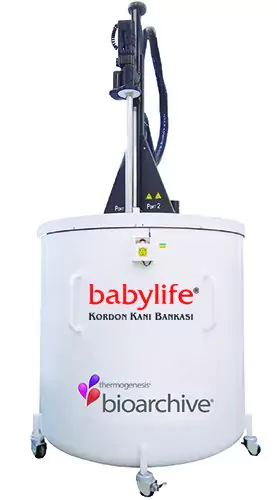BioArchive® Saklama Sistemi
Dünyadaki büyük kan bankalarının %90’ı Avrupadaki tüm kordon kanı bankalarının %75’i BioArchive® sistemini kullanıyorken Türkiye’de BioArchive® sistemi hizmete sunan tek banka Babylife Kordon Kanı Bankasıdır. Kordon kanının saklatılması kadar, saklandığı koşullar ve teknolojisi de önemlidir. Saklama koşulları kanın saklanabilme süresindeki en önemli faktördür. Aşağıda BioArchive® sistemin avantajları ve diğer bankaların kullandığı geleneksel saklama tanklarının farklarını mutlaka incelemenizi öneririz.

> Kök hücre depolanması için özel olarak tasarlanmıştır.
> ABD Gıda ve İlaç İdaresi (FDA) tarafından onaylandı.
> 37 ülkede 129 kordon kanı bankası tarafından kullanılmaktadır.
> Dünya çapında büyük kan bankaları, Avrupa’daki kordon kanı bankalarının %90’ı ve dünyanın ilk kordon kanı bankası olan, dünya çapında nakillerin çoğunu yapan New York Kan Merkezi (New York Blood Center) tarafından kullanılmaktadır.
> Küresel kordon kanı nakillerinin % 75’i üzerinde kök hücre örneği sağladı 17
> Tam otomatik robotik kol tarafından gerçekleştirilen depolama ve çıkarma işlemi.
> Geleneksel tanklarda görülen ve olası bir nakil şansını düşüren en büyük etmen olan “Geçici Isınma” (Transitient Warming Event-TWE) bu sistemde yaşanmaz. 18
> Uzun dönemli kök hücre saklanması için araştırma raporlarında önerilen sıvı azot ( -196˚C ‘de sabit sıcaklık) ortamı kullanılır.
> Hassas depolama-geri alma kaydına sahip dahili bilgisayarlı kayıt-takip sistemi.
> Sıvı azot rezervuarı, elektrik kesintisi durumunda 50 günden fazla süre boyunca -196 ˚C sabit sıcaklık sağlayabilir.
Hücre Canlılığı Başarılı Nakil Oranının Anahtarıdır
Kordon kanı ve göbek kordonunun depolanması, çocuklarınız ve aileniz için ömür boyu koruma sağlar. Hiç kimse bir gün bunu kullanma şansına nail olmak istemez. Ancak gerek olursa, kök hücrelerin düşük düzeyde canlılığının; kordon kanının ve göbek kordonunun işlevlerini kaybetmesine izin vereceğini biliyor musunuz? Babylife, dünyadaki çoğu kamu kan bankası tarafından (New York Kordon Kan Merkezi, Tokyo Kordon Kan Bankası ve dünya çapındaki büyük kan bankaları dahil) kabul edilen BioArchive® sıvı azot depolama sisteminin Türkiye’deki tek temsilcisidir. Depolama ortamı olarak sıvı azotun (-196 ° C’de sabit sıcaklık) kullanılması, uzun süreli kök hücre depolanması üzerine hazırlanan raporlar tarafından önerilmektedir. Sadece sıvı azot -196 ° C sıcaklıkta sabit kalabilir ve kordon kanı kök hücrelerin tüm fizyolojik aktiviteleri bu sıcaklıkta askıya alınır. Saklanan hücrelerin canlılığının uzun yıllar korunabilmesi bu sıcaklıkta kalması gerekir. Aksi taktirde Geçici Isınma (TWE) sonucu hücrelerin canlılığında azalma görülecek, bu da ileride kana nakil için ihtiyaç duyulması durumunda nakil başarısını riske atacaktır.
BioArchive ® Sistemi |
Geleneksel Tanklar |
|
| Özgünlük | ✅ Kök hücre depolaması için özel olarak tasarlandı | Χ Biyolojik numunelerin depolanması için genel kullanım amaçlı |
| Bebeğin değerli kök hücrelerini korumak için özel ileri teknoloji. | ||
| Saklama Ortamı |
✅ Optimum kök hücre canlılığını sağlamak için kararlı sıcaklık
✅ Sabit sıcaklıkta (-196˚C), 1000 yıldan uzun süre kalıcı saklama ✅ Sıvı azot rezervuarı, elektrik tedariki olmadan 50 günden fazla bir süre boyunca hiç sıcaklık artışı olmadan kök hücreleri koruyabilir. |
Χ Sürekli sıcaklık dalgalanmaları (TWE-Transient Warming Event) sonucu daha düşük hücre canlılığı
Χ Uzun süreli depolama için azot buharının kullanılabileceğine dair hiçbir bilimsel kanıt yoktur Χ Azot buharındaki numuneler sadece ~ 20 gün saklanabilir |
| Size Artısı | Geleneksel tanklara göre çok daha maliyetli olan BioArchive® sistemi, kök hücrelerin canlılığını maksimum düzeyde korumak adına Türkiye’de sadece Babylife kullanmaktadır. | |
| Tasarım ve İşletme |
✅ Sabit depolama sıcaklığına sahip kapalı tasarım
✅ Robotik kol sayesinde kanın depolanması ve alınması sırasında diğer kanlar işlemden etkilenmez. ✅ “Geçici ısınma” (TWE), eradike edilerek (tamamen yok edilerek) yüksek kök hücre canlılığı garanti edilir. ✅ Anında alarm veren 24 saat aktif dahili gözetim sistemi ✅ Acil durumda örneklere erişmek için manuel mod ✅ Yalnızca örnek kayıtları içerir, kişisel verilere erişilme riski yoktur ✅ Başkalarını etkilemeden numunelerin periskop ile bağımsız erişimi |
Χ Kanların depolanması ve alınması sırasında tank içi sıcaklık dengesizliklerine ve bakteriyel kirlenmeye zemin hazırlayan açık sistem
Χ Geleneksel tanktan numune alınması-konulması sürecinde gerçekleşen “geçici ısınma“(TWE) tanktaki tüm hücrelerin canlılığında azalmalara yol açabilir. Χ Kapsayıcı olmayan ve modası geçmiş dışarıdan gözleme dayalı sistem Χ İnsan hatası riski yüksek olan, hatalara davetiye çıkaran manuel işletim
|
| Size Artısı | Tam otomatik kapalı sistem, kordon kanı ve kordon kök hücrelerinin kalitesini etkileyebilecek manuel hatalardan ve TWE’lerden kaçınabilir. | |
| Kontrollü Dondurma Hızı |
✅ Entegre kontrollü dondurucu sistemi “geçici ısınma“yı (TWE) engeller.
✅ Kök hücre canlılığı için optimum donma hızı 2.8 ℃/dk |
Χ Harici donma prosedürü, numunelerin -190 ℃’den oda sıcaklığına maruz kalmasına neden olur. Aşırı sıcaklık farkı kök hücrelerde ciddi hasara neden olur. (% 2-4 kayıp)
Χ Uzun süren ve kontrolsüz donma süreci (~ 120 dk) |
| Size Artısı | Özel entegre kontrollü hızda dondurucu, işlemlerin kısa ve kontrollü sürede tamamlanmasına olanak sağlar. | |
| Kök Hücre Kalitesi |
✅ %97’nin üzerinde CD34+ canlılığı ile diğer saklama yöntemlerine göre inkar edilemez üstünlük
✅ Çözündürme sonrası %94’den fazla hücre canlılığı |
Χ Azot buharı ve “geçici ısınma“nın kombine etkisi ile hücre canlılığında %20 azalma |
| Size Artısı | Depolama ortamı olarak kapalı sistem ve sıvı azot kullanılması, kök hücreleri ileride kullanmak üzere uzun yıllar boyunca yüksek canlılık oranıyla korur. | |
| Başarılı Nakil |
✅ Nakil sonrası sağ kalım oranı geleneksel tanklara göre %10 daha yüksektir
✅ Dünya çapında başarılı nakillerin %75’ini sağladı |
Χ “Geçici ısınma” başta olmak üzere canlılık azalmasından kaynaklı daha düşük başarı şansı |
| Size Artısı | BioArchive ® sisteminden nakil için kök hücre alan hastanın sağkalım oranı, geleneksel azot buharı depolama sistemi kullananlardan% 10 daha yüksektir | |
| Global Kullanım |
✅ Netcord üyesi kordon kanı bankalarının %80’i kullanıyor
✅ Dünya çapındaki çoğu kamu kan bankası tarafından tercih edilmiştir (New York Kordon Kan Merkezi, Tokyo Kordon Kanı Bankası vb)
|
Χ Kurulum ve işletim maliyeti düşük olduğundan Türkiye’deki özel kordon kanı bankaları tarafından tercih edilmektedir. |
| Size Artısı | Dünya’da başı çeken bankalarla birlikte üstünlüğü kıyas götürmez bu sistemi kullanan Türkiye’deki tek firma Babylife’dır. | |
|
Çapraz bulaşma |
✅ Kayda geçmiş çapraz kirlenme olayı yok
✅Kordon kanı; sıvı azot ya da azot buharında bulunduğu farketmeksizin tamamen hava geçirmez ortamda olmadığı sürece çapraz kontaminasyon yaşanabilir ✅Raporlar, mühürlü BioArchive® saklama kasetlerinin (her kök hücrenin kendi mühürlü kasedi vardır) sıvı azot deposuyla çapraz kontaminasyonu giderebileceğini gösterdi
|
Χ Çapraz kontaminasyon vakaları gerçekleşti |
Geçici Isınma Olayları (TWE'ler) - Kök Hücrelerin Canlılığını Azaltır ve Nakil Kalitesini Etkiler
Geçici Isınma (Transient Warming Event), kordon kanı kök hücreleri -196°C’de dondurulmuş haldeyken, saklama tankından dışarı alınması, saklama tankına başka kordon kanı ilavesi, tanktaki kordon kanlarından birinin alınması gibi durumlarda geçici olarak normal sıcaklıktaki havaya maruz kalmasından kaynaklanan, tankta ani sıcaklık dalgalanmalarına neden olan durumu ifade eder. Bu tür tekrarlanan sıcaklık dalgalanmaları nihayetinde kök hücrelerin ölerek canlılığın azalmasına neden olmaktadır. Araştırmalar, geçici ısınma olaylarının kök hücre sayısını azaltacağını ortaya koydu. Geçici ısınma nedeniyle milyonlarca kök hücre kaybedilmektedir. Bir başka rapor, buhar azotunun geçici ısınma olayları ile bir araya gelmesinin% 20 oranında yaşayabilirlik kaybına neden olabileceğini göstermektedir . Sonuç olarak araştırmacılar kordon kanı bankalarını geçici ısınma olaylarına karşı önlemler almaları için uyarmaktadır. Çünkü kan naklinin (transplantasyon) başarısındaki en önemli etmenlerden biri saklanan kandaki canlı hücre sayısıdır.
